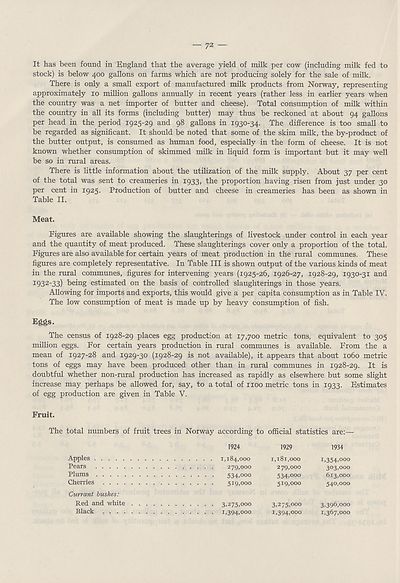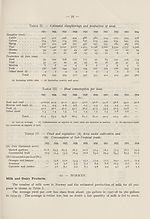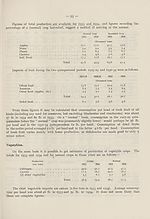Download files
Complete book:
Individual page:
Thumbnail gallery: Grid view | List view

— 72
It has been found in England that the average yield of milk per cow (including milk fed to
stock) is below 400 gallons on farms which are not producing solely for the sale of milk.
There is only a small export of manufactured milk products from Norway, representing
approximately 10 million gallons annually in recent years (rather less in earlier years when
the country was a net importer of butter and cheese). Total consumption of milk within
the country in all its forms (including butter) may thus be reckoned at about 94 gallons
per head in the period 1925-29 and 98 gallons in 1930-34. The difference is too small to
be regarded as significant. It should be noted that some of the skim milk, the by-product of
the butter output, is consumed as human food, especially in the form of cheese. It is not
known whether consumption of skimmed milk in liquid form is important but it may well
be so in rural areas.
There is little information about the utilization of the milk supply. About 37 per cent
of the total was sent to creameries in 1933, the proportion having risen from just under 30
per cent in 1925. Production of butter and cheese in creameries has been as shown in
Table II.
Meat.
Figures are available showing the slaughterings of livestock under control in each year
and the quantity of meat produced. These slaughterings cover only a proportion of the total.
Figures are also available for certain years of meat production in the rural communes. These
figures are completely representative. In Table III is shown output of the various kinds of meat
in the rural communes, figures for intervening years (1925-26, 1926-27, 1928-29, 1930-31 and
I932_33) being estimated on the basis of controlled slaughterings in those years.
Allowing for imports and exports, this would give a per capita consumption as in Table IV.
The low consumption of meat is made up by heavy consumption of fish.
Eggs.
The census of 1928-29 places egg production at 17,700 metric tons, equivalent to 305
million eggs. For certain years production in rural communes is available. From the a
mean of 1927-28 and 1929-30 (1928-29 is not available), it appears that about 1060 metric
tons of eggs may have been produced other than in rural communes in 1928-29. It is
doubtful whether non-rural production has increased as rapidly as elsewhere but some slight
increase may perhaps be allowed for, say, to a total of 1100 metric tons in 1933. Estimates
of egg production are given in Table V.
Fruit.
The total numbers of fruit trees in Norway according to official statistics are:—
Apples .
Pears
Plums
Cherries
Currant bushes:
Red and white
Black . . . .
1924
1,184,000
279,000
534»000
519,000
3,275,000
1,394,000
1929
x,181,000
279,000
534>000
519,000
3,275,000
1,394,000
1934
1,354,ooo
303,000
613,000
540,000
3,396,000
1,367,000
It has been found in England that the average yield of milk per cow (including milk fed to
stock) is below 400 gallons on farms which are not producing solely for the sale of milk.
There is only a small export of manufactured milk products from Norway, representing
approximately 10 million gallons annually in recent years (rather less in earlier years when
the country was a net importer of butter and cheese). Total consumption of milk within
the country in all its forms (including butter) may thus be reckoned at about 94 gallons
per head in the period 1925-29 and 98 gallons in 1930-34. The difference is too small to
be regarded as significant. It should be noted that some of the skim milk, the by-product of
the butter output, is consumed as human food, especially in the form of cheese. It is not
known whether consumption of skimmed milk in liquid form is important but it may well
be so in rural areas.
There is little information about the utilization of the milk supply. About 37 per cent
of the total was sent to creameries in 1933, the proportion having risen from just under 30
per cent in 1925. Production of butter and cheese in creameries has been as shown in
Table II.
Meat.
Figures are available showing the slaughterings of livestock under control in each year
and the quantity of meat produced. These slaughterings cover only a proportion of the total.
Figures are also available for certain years of meat production in the rural communes. These
figures are completely representative. In Table III is shown output of the various kinds of meat
in the rural communes, figures for intervening years (1925-26, 1926-27, 1928-29, 1930-31 and
I932_33) being estimated on the basis of controlled slaughterings in those years.
Allowing for imports and exports, this would give a per capita consumption as in Table IV.
The low consumption of meat is made up by heavy consumption of fish.
Eggs.
The census of 1928-29 places egg production at 17,700 metric tons, equivalent to 305
million eggs. For certain years production in rural communes is available. From the a
mean of 1927-28 and 1929-30 (1928-29 is not available), it appears that about 1060 metric
tons of eggs may have been produced other than in rural communes in 1928-29. It is
doubtful whether non-rural production has increased as rapidly as elsewhere but some slight
increase may perhaps be allowed for, say, to a total of 1100 metric tons in 1933. Estimates
of egg production are given in Table V.
Fruit.
The total numbers of fruit trees in Norway according to official statistics are:—
Apples .
Pears
Plums
Cherries
Currant bushes:
Red and white
Black . . . .
1924
1,184,000
279,000
534»000
519,000
3,275,000
1,394,000
1929
x,181,000
279,000
534>000
519,000
3,275,000
1,394,000
1934
1,354,ooo
303,000
613,000
540,000
3,396,000
1,367,000
Set display mode to:
![]() Universal Viewer |
Universal Viewer | ![]() Mirador |
Large image | Transcription
Mirador |
Large image | Transcription
Images and transcriptions on this page, including medium image downloads, may be used under the Creative Commons Attribution 4.0 International Licence unless otherwise stated. ![]()
| League of Nations > Economic and financial section > Problem of nutrition > (74) |
|---|
| Permanent URL | https://digital.nls.uk/190928312 |
|---|
| Shelfmark | LN.II |
|---|
| Description | Over 1,200 documents from the non-political organs of the League of Nations that dealt with health, disarmament, economic and financial matters for the duration of the League (1919-1945). Also online are statistical bulletins, essential facts, and an overview of the League by the first Secretary General, Sir Eric Drummond. These items are part of the Official Publications collection at the National Library of Scotland. |
|---|---|
| Additional NLS resources: |
|

